Hi everyone! I'm a forum newbie who hasn't sailed in nearly 25 years. I just picked up a beat-up old Starfish hull. I understand this is a Sunfish clone made here in Texas. That's about all I know... I have no clue as to how old this thing is.
From the looks of it, I'd guess it's about 100 years old. The gelcoat appears to have literally cooked in the Texas sun for years. Worse, it has numerous dubious looking patches on the bow and hull bottom. What's left of the bottom paint looks like flat latex barn paint. The only good news? I weighed the hull and it's around 122#'s, hopefully meaning it has dried out. I have no doubt that if it went anywhere near water with these patches the foam has been waterlogged.
Oh, there is no daggerboard, rudder or tiller... but I do have a decent mast and sail from a sunfish.
Basically, my plan is to get this thing back on the water as cheaply as possible. I want to use it as a trainer - to introduce my wife to sailing. It doesn't have to be a show winner, I just want it to look respectable and sail right.
I owned and raced catamarans in the early 80's and have some time in monohulls - mainly recreational sailing in friends boats... including Lasers and a Sunfish. I also have some limited fiberglass experience - from working on my cat's keels (the beaches here are pretty rocky).
Anyway, I wanted to introduce myself and get some advice. I'm open to any and all suggestions!
From the looks of it, I'd guess it's about 100 years old. The gelcoat appears to have literally cooked in the Texas sun for years. Worse, it has numerous dubious looking patches on the bow and hull bottom. What's left of the bottom paint looks like flat latex barn paint. The only good news? I weighed the hull and it's around 122#'s, hopefully meaning it has dried out. I have no doubt that if it went anywhere near water with these patches the foam has been waterlogged.
Oh, there is no daggerboard, rudder or tiller... but I do have a decent mast and sail from a sunfish.
Basically, my plan is to get this thing back on the water as cheaply as possible. I want to use it as a trainer - to introduce my wife to sailing. It doesn't have to be a show winner, I just want it to look respectable and sail right.
I owned and raced catamarans in the early 80's and have some time in monohulls - mainly recreational sailing in friends boats... including Lasers and a Sunfish. I also have some limited fiberglass experience - from working on my cat's keels (the beaches here are pretty rocky).
Anyway, I wanted to introduce myself and get some advice. I'm open to any and all suggestions!

 Do you have progress pics on here?
Do you have progress pics on here?

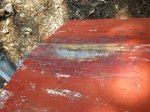
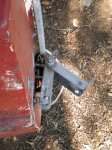
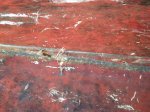
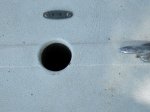
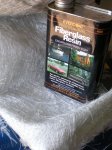
 Years ago I also did fiberglass work on the keels of both my Hobie 16 and 18. This was due to constantly beaching them on gravel and rocks. I finished those repairs with gelcoat like the guy in the video and they turned out fine.
Years ago I also did fiberglass work on the keels of both my Hobie 16 and 18. This was due to constantly beaching them on gravel and rocks. I finished those repairs with gelcoat like the guy in the video and they turned out fine.